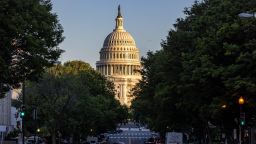It was a moment of triumph, hewn from tragedy and years in the making, as the US Senate finally acted after the horror of yet another mass killing and passed the most significant firearms legislation in nearly a generation.
Yet in a cruel twist, the life’s work of many bereaved relatives turned activists was overshadowed before it happened by an even longer-fought victory for the gun lobby that throws into grave doubt government’s power to regulate firearms.
Supporters say the new bill, which the House is expected to pass on Friday, will save thousands of lives. It contained several key goals of firearms safety advocates and was pushed over the line amid public revulsion after recent massacres in Uvalde, Texas, and Buffalo, New York.
But its Senate passage was accompanied by an even more strident demonstration of the power of the pro-gun movement, after the conservative US Supreme Court majority leveled a huge blow at the capacity of states to restrict the carrying of guns outside the home. By throwing out a long-established New York law, the high court opened the door to a possible gun-toting future with few limits on the Second Amendment, which critics say will swell America’s never-ending epidemic of firearm deaths.
Both political victories that unfolded on Thursday were the result of diligent, long-term activism. The Senate gun vote might not have happened were it not for the commitment of parents of children murdered at a Newtown, Connecticut, elementary school in 2012 and at a high school in Parkland, Florida, in 2018 and the bravery of bereaved family members from Buffalo and Uvalde who shamed Congress into action at a recent hearing.
Thursday’s Supreme Court opinion was also the product of generational political campaigning, in this case by conservatives who strove for decades through successive presidential elections to remake the court so a right-wing majority would be willing to rip up a century-old law like the one in New York. Justice Clarence Thomas, for example, who penned Thursday’s majority opinion, was nominated by President George H.W. Bush in 1991 and silently waited out more liberal eras for his right-wing jurisprudence and expansive views on gun rights to dominate the court.
That America’s dueling visions of its purpose and the meaning of its founding values played out in rival, long-term political campaigns is how it should work in a democracy, even if liberals carp at the procedural chicanery then-Senate Majority Leader Mitch McConnell employed to build the conservative majority on the court.
Yet the emerging power of the court’s 6-3 right-wing bloc – not just on guns, but on abortion, on slashing government regulation and on criminal justice issues – suggests a new conservative era is dawning. And given the age makeup of the justices, it could last for decades and long frustrate liberal political movements.
A landmark for firearms safety advocates
The guns bill garnered the votes of 15 Republican senators largely because it was credible to argue that it did not curtail broad Second Amendment rights, even if zealots like ex-President Donald Trump claimed that it did.
The measure locks in long-sought Democratic wins on closing the “boyfriend loophole,” which would extend prohibitions on getting guns to people convicted of domestic violence against romantic or intimate partners. The bill could make it take a little longer for people younger than 21 to buy guns – a nod to the fact that the Buffalo and Uvalde rampages were carried out by 18-year-olds who had purchased guns legally. And it invests in mental health and crisis intervention measures. But it lacks changes demanded by some Uvalde victims and President Joe Biden, like a ban on assault weapons.
Still, the measure is important because it dismantles the idea that trying to enact any gun restrictions in Congress is futile, given Republican dedication to the gun lobby. Activists hope it could prove to GOP lawmakers that they can vote to enhance gun safety and still keep their seats.
“We’re on the cusp of the cathartic moment in Congress we’ve been waiting for for a generation,” said Shannon Watts, founder of Moms Demand Action, a gun reform group, after an earlier procedural vote, which was staggering itself, given that 15 GOP senators joined the Democratic majority.
It’s impossible to know, but if the legislation had been in place before Uvalde or Buffalo, perhaps it could have averted the tragedies. It might thwart a future massacre, and if it saves lives, it is worth doing despite its modest scope.
But given the Supreme Court’s unfettered interpretation of the Second Amendment in its Thursday majority opinion, the bill may also be a harbinger of the limited ways future legislation will be able to try to address mass shootings – in other words, by not restricting the availability of guns themselves, but legislating around them. As it stands, it appears the measure passed on Thursday wouldn’t be affected by the Thomas decision – testimony in part to its limited reach.
A moment Thomas waited decades for
The Thomas opinion represented the most audacious move by the court against gun restrictions in years.
The veteran justice argued that the New York law, which required people to show the government why they needed to carry weapons for self-defense in public, was unconstitutional since citizens didn’t have to provide similar reasoning for exercising their free speech rights under the First Amendment or their right to confront witnesses against them under the Sixth Amendment.
His decision cements a conservative doctrine that prizes a literal reading of the Constitution. That reading, however, ignores modern mores, the reality of the nation’s agony over gun violence caused by weapons the Founders could never have envisaged and the majority public opinion on the need for reasonable gun control.
This was a point picked up by liberal Justice Stephen Breyer in his dissent. “In my view, when courts interpret the Second Amendment, it is constitutionally proper, indeed often necessary, for them to consider the serious dangers and consequences of gun violence that lead States to regulate firearms,” he wrote.
He also argued that the majority approach raised the question of whether guns will now simply be allowed everywhere and what the extent of the powers to regulate them will be. “What about subways, nightclubs, movie theaters and sports stadiums?” he asked in the dissent.
Breyer’s point raises the possibility that in many more liberal states, where guns were allowed in homes but not necessarily in public, Americans will now have to get used to far more lax standards imposed by unelected conservative justices. The ruling triggered anger from Democratic state leaders and law enforcement officials in New York and elsewhere, as well as from Biden and advocates of stricter gun safety measures, who predicted it would trigger widespread violence.
“This decision is deeply destructive to responsible prevention of gun violence,” Democratic Sen. Richard Blumenthal of Connecticut said on CNN’s “The Situation Room with Wolf Blitzer.” “It will unleash gun violence in many communities across America because it justifies very, very broad rights to carry firearms in public. It will lead to more guns in public and likely more gun deaths and injuries in public.”
A politicized court
Some critics have commented that such rulings prove the hyper-politicization of the new Supreme Court majority.
For instance, according to a draft opinion leaked earlier this year, the court may be about to overturn the landmark Roe v. Wade ruling guaranteeing the constitutional right to an abortion and send decisions on whether a woman can end a pregnancy back to the states to decide. Yet in the New York case, the court is establishing exactly the opposite principle about state and local control, saying local leaders cannot enact certain gun safety measures, even if that’s what their constituents want. On its face, this is illogical and appears tailored to fit the political proclivities of the right-wing movement. A conservative originalist jurist, however, would respond simply that there is no right to an abortion in the Constitution, whereas the right to bear arms is clearly stated.
On the narrower issue of guns, Thursday’s judgment is likely to lead to a cascade of lawsuits based on the Thomas opinion taking aim at guns laws nationwide. And lower-court judges will now effectively be forced to adopt the conservative majority’s view that there are almost no limits on the Second Amendment.
If, as expected, the court acts to end abortion rights in the coming days, on top of its controversial ruling on firearms, it will further ignite a firestorm against the conservative majority’s enthusiasm in using its new power. The right wing on the court is at odds with most public opinion on those two issues, a fact that will further damage its already tarnished capacity to present itself as above politics – and will deepen questions about its legitimacy in the eyes of millions of Americans. Just 25% of Americans now say they have “a great deal” or “quite a lot” of confidence in the Supreme Court, according to a Gallup poll released Thursday, which marks a new low.
Assuming no future Democratic president or Congress embraces the radical move of expanding the court to balance the conservative majority, the only remedy for frustrated liberals will be a long-term political one. The conservative majority was constructed over decades, and it would take similarly long to dismantle it – over many presidential elections.
Until then, juxtapositions like Thursday’s – when a moderate, bipartisan political success on an issue like guns is countermanded by the might of the Supreme Court’s right-wing bloc – will be an enduring and dominant story of American politics.




